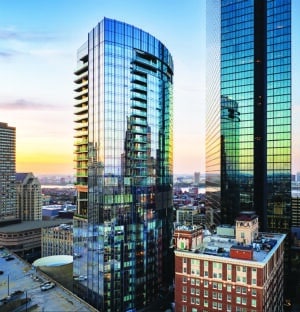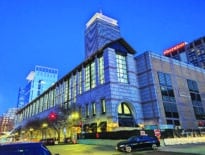
The architects and development team behind Raffles Boston sought to create vitality and community through the way food and beverage offerings were integrated into the building’s public and common spaces. Photo by Ed Wonsek | Courtesy of The Architectural Team
I was taken aback when developer Jordan Warshaw declared that the Noanet Group would be using the “F” word extensively in marketing Raffles, a statement especially surprising for a hotel brand as elegant and sophisticated as Raffles.
However, the choice naturally followed the decision to banish the “L” word.
“We forbade the use of ‘luxury’ in any marketing of Raffles. It’s so tired and overused and applied to practically every hotel or residential project from mid-market and above,” Warshaw told me.
He has a point. The application of such a word to the Raffles Boston, arguably the pinnacle of the hospitality market, is downright demeaning.
“Instead, we opted for the ‘F’ word. ‘F’ for Fun,” said Warshaw. “You don’t need to say ‘luxury’ once you say ‘Raffles’. The luxury part speaks for itself.”
Warshaw managed the project with co-developer and hotelier Gary Saunders.
“We wanted to create a vertical village, a vertical urban neighborhood filled with a variety of experiences,” Saunders told me.
Not a Box to Be Checked
A key element of the fun is food and beverage, or “F&B” in hospitality parlance, a contraction which, when spoken quickly, might be mistaken for phrase overheard in a bar in South Boston.
Raffles Boston’s approach to F&B is where the development team consciously departed from the industry trend of incorporating as little of it as possible into the hotel program.
Industry reasons for avoiding hotel F&B are reasonable and quantifiable. The support infrastructure in setting up and servicing commercial kitchens is capital intensive, not only in equipment and mechanical systems, but in the amount of space they occupy.
Operational costs in labor-intensive staffing, food material, food delivery and waste disposal further discount profitability as a return on a per-square-foot basis when compared with hotel room revenue. Many brands, even some “luxury” brands, seem to approach food-and-beverage only as an unavoidable box to be checked.
Not so at Raffles.
Creating Community Through Concessions
Saunders said the food-and-beverage program creates a buzz that promotes vitality. Four of the five venues are integrated and open to the public areas of the hotel and become part of a carefully orchestrated circulation sequence through the building.
The Patisserie is located on the first floor, accessible from both the hotel and Raffles residences’ first floor lobbies as well as a direct entrance from the street. La Padrona, Jody Adams’ much-anticipated restaurant, is located both adjacent to the first-floor hotel lobby as well as the second floor.
Express elevators to the 17th floor open to hotel check-in, lounge and concierge functions as well as two food-and-beverage destinations.

Michael Liu
Turn right for a view into Amar, a Portuguese-themed restaurant, or to the left to the celebrated Long Bar, the signature cocktail lounge which is always a part of every Raffles hotel – and at Raffles Boston, is adjacent to a sky terrace.
Or proceed straight ahead and up the helical staircase to the 18th floor, down a corridor and turn right and find yourself in The Blind Duck. This fifth venue is consciously hidden away as appropriate for a speakeasy: a destination for those in the know.
At the condominium portion of Raffles Boston, residents frequent the restaurants as a natural adjunct to their extensive and varied common amenities, mingling with neighbors as well as the public.
This has promoted an unusual sense of community in the building: so different than the anonymity common in many upmarket urban condominium buildings. That neighborly vibe permeates the hotel atmosphere and is in keeping with Raffles’ emphasis on personal contact with guests and visitors, further supported by the intimate quality of the public areas.
The result, Warshaw said, is “a total integration of design, program and brand.”
Michael Liu is senior partner and design principal at The Architectural Team.






